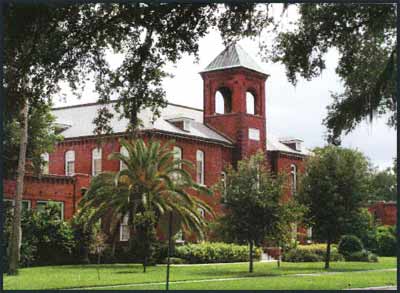A 110-year-old school museum in Sanford soon will become the home of the new UCF Center for Public History, where university students will learn how to preserve, interpret and teach the past.
A two-year lease was signed last week with the Seminole County School Board to start classes and programs at its Student Museum in July. The 1902 building in the middle of the city’s historic district was listed on the National Register of Historic Places in 1984.
“The Student Museum building is an ideal site because of its own rich heritage as well as the City of Sanford’s significant architectural history and grassroots historic-preservation movement,” said Rosalind Beiler, UCF’s director of Public History.
The new center at 301 W. 7th St. is intended to foster a close connection between the community and UCF’s research projects. “By definition, public history engages community partners,” Beiler said.
The university will blend the old and the new with its plans for the museum. While maintaining the museum’s current offerings – such as leading 4th graders on field trips through the museum to learn about Florida’s past – the university will teach its history students how to use new-media techniques of audio, video and digital technologies to create virtual exhibits, artifact databases, podcasts and other projects.
“Through this partnership, we will preserve an important link between today’s tech-savvy students and how our ancestors lived and worked more than a century ago,” said UCF Provost and Executive Vice President Tony G. Waldrop. “The museum also is an outstanding laboratory that will prepare our students for careers in a field that helps all of us connect with and learn from our past.”
Beiler said the university chose Sanford because the city is already committed to historic preservation through the Community Redevelopment Association, Historic Preservation Board and Sanford Historic Trust. The university is planning to hold public workshops and seminars at the Student Museum, along with gathering oral histories.
“This partnership preserves an important part of history for Sanford, Seminole County, students and the whole community,” said Bill Vogel, Seminole’s schools superintendent. “This is so important to the whole preservation efforts of Sanford. Because of UCF, this could be a centerpiece.”
The Student Museum is one of the few surviving examples in Florida of school architecture at the turn of the 20th century. The 20,000-square-foot Romanesque Revival brick building opened as Sanford’s first high school and became a grammar school in 1911. In 1984, it was given the title of Student Museum and Center for the Social Studies, and it has since served as an interpretive center and a hands-on teaching museum.
UCF students will be able to experience the museum’s 1902 classroom with original woodwork and slate boards, a portrait of then-President Theodore Roosevelt and other period artifacts; a Native American room that represents a 1,200-year-old Timucua village; and a pioneer room with a log cabin and tools. The museum also features Grandma’s Attic, where visitors can handle old household items, try on vintage clothes, learn how to churn butter and make candles; the Georgetown and Crooms High School exhibits, which feature information about the city’s African-American community; and other displays.
Behind the museum is a teaching garden that provides students the opportunity to plant and identify vegetables grown at the turn of the last century. There also are Florida native plants, antique roses, a wildflower meadow, field crops and other horticultural displays. Across the street from the museum is the city’s historic tree grove in Touhy Park, which contains about 70 trees that are associated somehow with people, places and events around the country. There are sycamores, magnolias, maples, walnuts and others from Valley Forge, Gettysburg, Mount Vernon, Ellis Island, the Alamo and elsewhere.
“Kids thrive on these historical projects, and teachers are going to flock to the center,” said Anna-Marie Cote, deputy superintendent for Seminole schools.
